Wisconsin: June 8-10
Flâneur is a wonderfully descriptive French noun referring to a “stroller, loafer, a lounger,” or as the Italians describe it, enjoying a “passeggiata.” In any language, it describes the passionate wandering traveler. In this, the aftermath of a disastrous Covid 2020, my heart is true but can it be a reality? Can’t go everywhere I want, so, seeking somewhere new, I join my friend Nancy and these Flâneries chose Wisconsin.
First, what’s it like traveling June 2021? I seldom travel during summer tourist season. Add hoards escaping “stay at home” requests and families traveling = challenging.
It appears flying is in an anal stage. I must assume most people do not read airline requirements or suggestions. For the first time, I witnessed airlines using its bag sizers and people offended that the number and size of carryon items were enforced. Testosterone wafted through the airport as mask wearing appeared a challenge for many men. Then there were the unfortunates who bought cheap economy tickets then became frustrated about airline restrictions that come with the price. Airports were packed, lines long, and overhead bins full: all reaffirming my aversion to summer travel.
WRIGHT AND WEIRD RESIDE IN WISCONSIN
Wisconsin’s rolling fields of corn have some distance to reach “knee high by 4th of July.” But the scenery is green and views sweep for miles. Views are something to appreciate. Country roads wind through pastured hills where red barns and white farmhouses dot wooded valleys. Here is a world of wide corn fields, radiant greens and every town’s unique water tower. Here, also, I discovered a unique side of Wisconsin. (Actually, I cheat a bit on this region of Wisconsin, having visited here in 1986 – but things change over 35 years, right?)
Two Spring Green neighbors shared magnificent views of River Valley but had distinctly different ideas about living here. After touring their individual homes, I realized why they might not have been on the best of speaking terms.
The natural landscape of southwest Wisconsin was the ideal location for Frank Lloyd Wright’s Taliesin (tally-ehssen), Welsh for shining brow, which overlooks the valley homesteaded by Wright’s ancestors. Taking an organized tour from the nearby visitor center, we were able to visit his beautiful 37,000 sq ft home, much of which is the same as when he and his mistress lived there. By the time Wright built Taliesin, he had mastered his iconic prairie style architecture with the use of natural stones and wood, open views, stained glass, natural light, and geometric lines. The home is perfectly in sync with nature and blends into the commanding hilltop. Built in 1911, Taliesin was rebuilt after fires in 1914 and 1925. Today, Taliesin is perfection.
Nearby Hillside School was built in 1902 for his aunts who operated the school. It contains living facilities, architect’s studio, and galleries of photos and models of Wright’s designs. Also on the grounds is the restored 1897 Romeo and Juliet windmill. Wright did not build just a windmill; the windmill consists of two intersecting towers, with Romeo as a triangular storm prow, supported by the octagonal Juliet. The aerodynamic structure allows storm winds to go around the windmill rather than pushing it down. Wright also designed the Visitor Center’s Riverview Terrace and Spring Green restaurant, unfortunately closed for Covid.
Wright’s career and influence spanned decades from the 1890s to the 1950s. Headlines haunted him after he left his third wife to live with his mistress at Taliesin. But the real tragedy happened in 1914. A disgruntled cook set fire to the dining room where his mistress was lunching with her young children, a friend and staff. Those who tried to escape were brutally axed by the demented man. Seven people died in the tragedy, including Wright’s mistress and children. Some of the scorched timbers were used to rebuild the home and serve as a poignant reminder to Wright (not for his third wife who outlived Wright and resided here after his death).
The 1886 Unity Chapel is across the road. Requested by his uncle/minister Jenkin Lloyd Jones, Wright designed the interior at the age of 18. Originally, Wright was buried here along with his uncle, mistress and other family members and the “kidnapping” of his remains is more colorful than the church. At the request of Wright’s third wife, who wanted him buried with her in Arizona’s Taliesin West, her friends exhumed Wright’s remains, cremated them and moved them to Arizona. One of Wright’s sons described it as “A childish stunt by a selfish woman carried out by a group of idolators.” Wright was a genius when it came to architecture. Not so much when it came to women.
WRIGHT NEXT DOOR
I earlier mentioned Wright’s neighbor. Madison businessman Alex Jordan sought a place to hang his hat. His dream was to sculpt a home of stone at one with the natural attributes of the Wisconsin countryside. Once finished, Jordan began to collect. His ever‑growing, ever‑changing vision became mind‑boggling. Wright had to have hated him.
Jordan’s House on the Rock takes imagination to its limit. Perched atop a 450‑foot rock chimney, his stone home is a maze of memorabilia, music and vast collections of “stuff.”
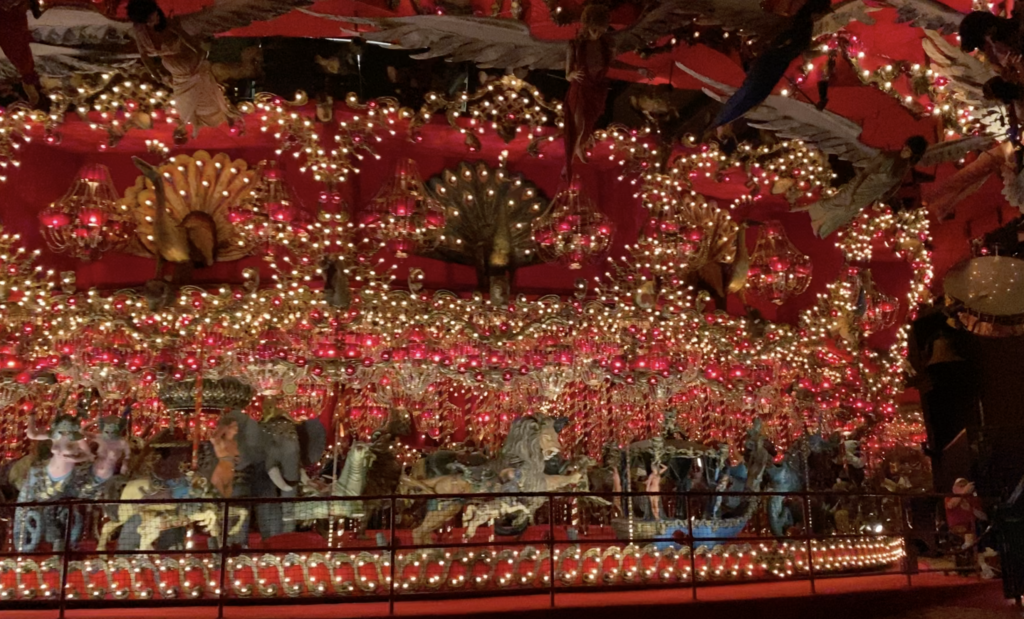
Attractions include a Circus Building with a 40‑piece band and 80‑piece orchestra, full‑sized elephants and countless animated devices. Jordan strove for superlatives! Red Room boasts the world’s largest carousel: 35 feet tall, 80 feet in diameter with 18,000 sparkling lights. None of its 269 animals, real or mythological, are alike. They include unicorns, tigers, reindeer, pigs and centaurs, but not one horse. Heritage of the Sea with a 200‑foot fiberglass whale, was completed after Jordan’s death in 1989. The Organ Building displays the world’s largest organ console. (Throughout the house are 52 grand pianos; 29 are wired to this console.) In fact, entire rooms become intricate, magical music boxes. Over 30 animated music machines effectively use illusion to entertain. Or produce a cacophony of noise, whichever you choose.
Kids will be captivated – adults may be horrified.
Jordan’s original house uses walls of natural rock, trees invade floors and ceilings, three‑story bookcases, waterfalls, fireplaces, “priceless” art and one‑of‑a‑kind leaded glass. His original 13 rooms can amaze although thereafter one becomes totally unprepared for what follows. The Infinity Room extends 218 feet, suspended 156 feet above the valley – once probably impressive now just a little tacky. As a result of the house’s popularity and, evidently, a subliminal suggestion to go forth and multiply, Jordan continued to expand his maze. He not only bought up items from every garage sale and going-out-of-business sale, but hired to have stuff made. With the sale of the house to a friend before Jordan’s death, his legacy continues.
Broader collections resulted in more rooms and a house (Jordan thankfully avoided the term museum) to captivate the imagination of every visitor and seemingly to trap Flâneries looking for an exit. Rampant commercialism has crept into its rooms. And if its floor to ceiling collections of books, paperweights, dollhouses, clocks, stained glass and stuff fascinates, good luck with understanding it as there are no explanations and a souvenir guidebook explains little.
But Jordan’s music machines forever play on.
COVID CLOSED DOORS
Eighteen miles south is the historic town of Mineral Point and Pendarvis. The skillful stonecutting and masonry of Cornish immigrants who mined for lead in the 1830s is evident in the restored limestone dwellings of this area. Driving Mineral Point’s “main street” is a dip back in time with a Ben Franklin 5-10, Pabst Blue Ribbon sign and Veteran’s Memorial. Sadly, this was our first experience with the closures brought on by Covid and a quiet Wisconsin town was even quieter.
We drove back to Spring Green and the unfussy bar called The Shed for a fantastic craft beer and delicious portobello mushroom sandwich. Had I known it would be the last good meal for a week, I would have had another sandwich to go.
DISNEY WATERPARK ON STEROIDS
I’ve driven through Wisconsin Dells many times on my Chicago to Duluth route. My friend thought to visit. The Dells is a region of endless theme parks including wildlife parks of captured mammals; Noah’s Ark, Polynesian, and Mt. Olympus waterparks; and innumerable pizza and hamburger joints. My first thought was how to artfully discourage her. I have always enjoyed the landscape and glacier-carved sandstone geology of the area so the recommendation for a cruise of the Dells was an excellent option.
The Dells of the Wisconsin River (fondly called Wisconsin Dells) is a 5-mile stretch of river with gorges and striking Cambrian sandstone rock formations. Originally referred to as the Dalles (narrows) by the French, the Dells is home to some of the most beautiful natural sandstone sculptures in the US. Some of the unique cliff faces tower over 100 feet above the river. This is all thanks to the last ice age some 15,000 years ago.
The area remained untouched by the huge Laurentide Glacier and became a part of what is now known as the Driftless Area that was spared by the large sheets of ice. The melting of Laurentide formed a massive glacial lake covering much of Wisconsin to depths of over 150 feet and held back by an even bigger ice dam. Eventually, the ice dam burst and unleashed a catastrophic flood. The lake’s depth dropped to only 50 feet and cut deep, narrow gorges in its wake to create the sandstone rock formations of the Dells. In geologic time, 15,000 years is short, but much of the rock dates back to the Cambrian era approximately 515 million years ago. So, a cruise on the Wisconsin River and Dells should be fantastic. Yes?
There are several boat tours of both lower and upper Dells. We chose the 2-hour Upper Dells. For best views one wants the top of the boat but that also means heat and sun. Be prepared.
The boat lazily maneuvers down the Wisconsin past natural rock formations with the ubiquitous cute names and photo ops. Included are two scenic shore landings without which the river would be pretty so-so. Witches Gulch is short walk through spectacular walls of sandstone and past Witches Waterfall (why are places always named for witches not warlocks?) to their refreshment stand.
A second stop and “legendary sight” is the two tall rocks at Stand Rock. Here, employees have bribed a non-union German Shephard to leap the 5-foot span for our amusement. Probably done for a lousy little biscuit and pat on the head.
A Dairy Queen is strategically located next to the kiosk selling the cruise tickets.
WAUSAU – MORE THAN INSURANCE
Eschewing overnight in the Dells, we drove north to Wausau and discovered some charm and good food. Numerous forest trails parallel the Wisconsin River and give respite from the heat. However, the best discovery was the umbrella-clad pedestrian 3rd Street in the heart of downtown, site of a restaurant-row food festival and live street music. For us, we chose the Lemongrass and dined on Pad Thai and craft beer.
Tomorrow, we continue our flâneuring as we drive further north to Upper Michigan and hopefully a drop in temperature.
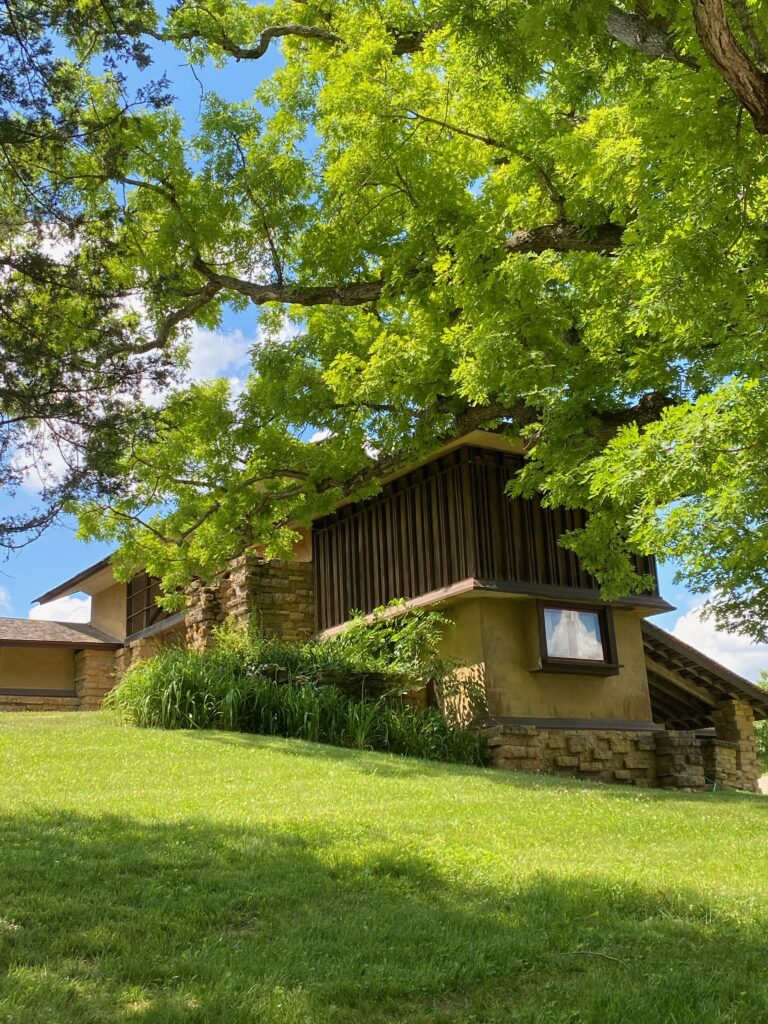

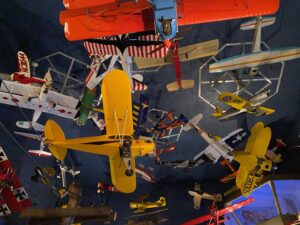
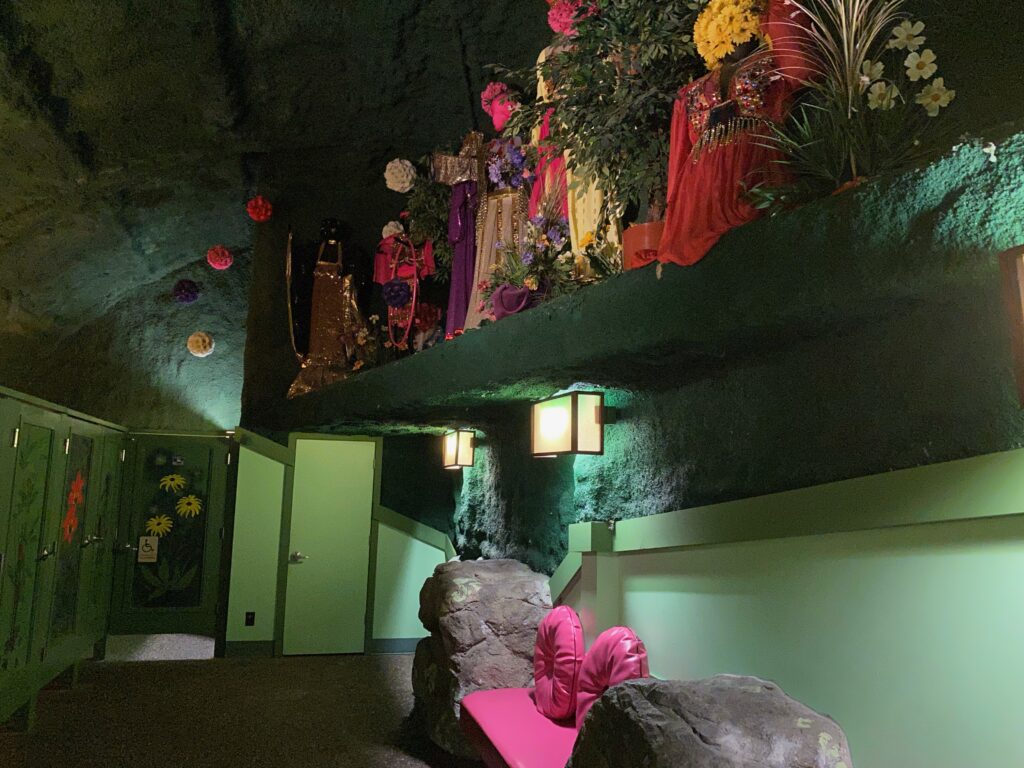
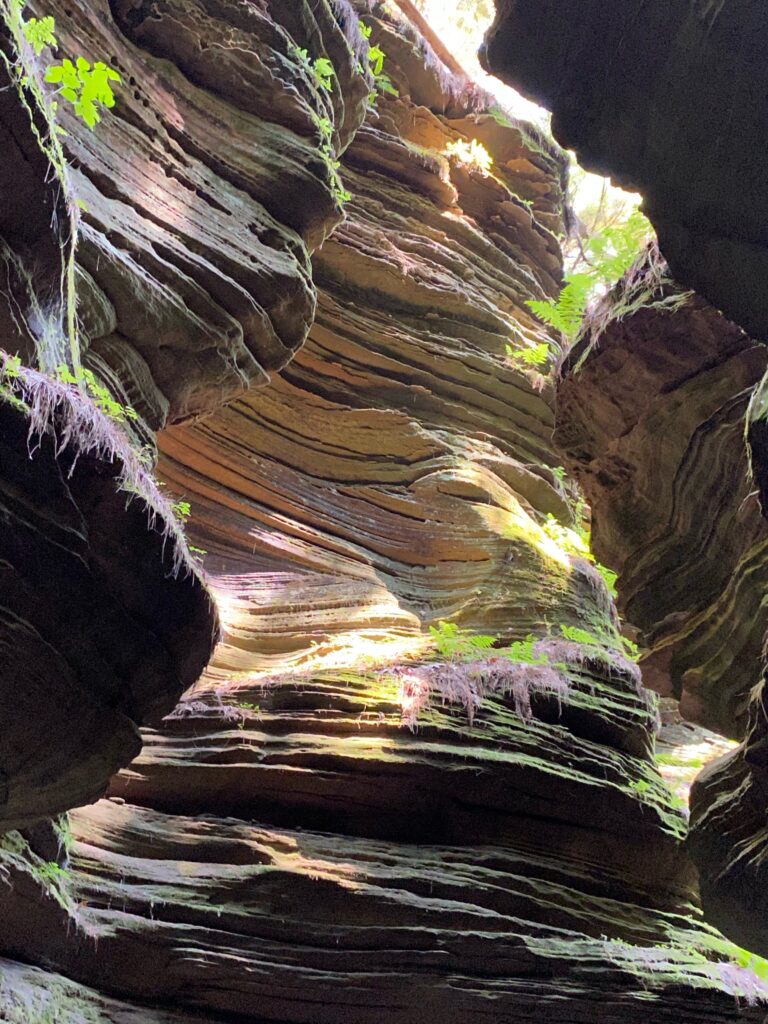
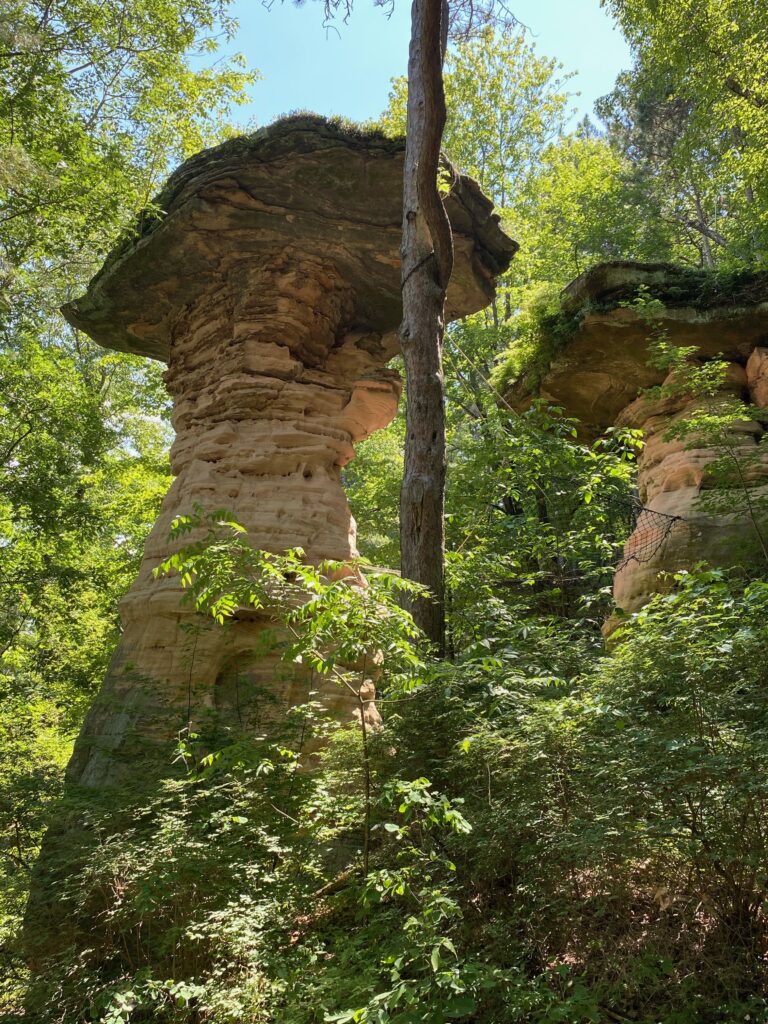

0 Comments